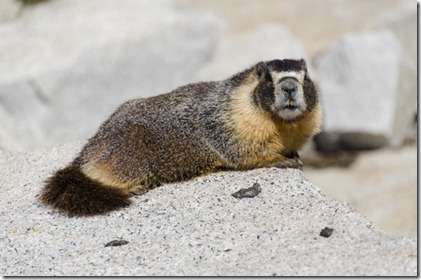Guess the animal
Marmot
DISTRIBUTION, ABUNDANCE, AND SEASONALITY
The yellow-bellied marmot is common and widespread in, or near, rocky areas in the Sierra Nevada, Cascades and White Mts. Optimum habitats are alpine dwarf-shrub, perennial grassland, wet meadow, subalpine conifer, and open stands of lodgepole pine forest. Also found in open, grassy understories of mixed conifer, montane riparian, red fir, eastside pine, montane chaparral, sagebrush, bitterbrush, low sage, aspen, Jeffrey pine, and pinyon-juniper habitats.
SPECIFIC HABITAT REQUIREMENTS
Feeding: This herbivore feeds on seeds, flowers, leaves, and stems of a wide variety of grasses, forbs, and shrubs, and it occasionally eats insects. It forages on the ground. Fat (to 50% of body weight) is accumulated prior to hibernation. Marmots appear to avoid plants with known high concentrations of secondary compounds such as alkaloids or tannins.
Cover: Uses rocky areas and talus for cover. Digs a burrow system as a refuge and hibernaculum. Burrow usually is under rocks, but also may be under tree roots or buildings.
Reproduction: Builds a nest of dry grasses in the burrow system.
Water: Drinks water while active. Captive animals from a xeric habitat drank less and produced less, and more concentrated, urine than animals from a mesic habitat In the xeric habitat, 73-74% of the total water intake came from drinking, and the remainder came from vegetation and metabolic water.
Pattern: Prefers rocky outcrops and talus slopes with nearby grasses and forbs. Uses rocks for shelter, sunning, and observing. Uses open stages of forests if an understory of grasses and forbs is present. Requires water source. May avoid areas of heavy grazing. In the Sierra Nevada, large populations may be found in, and around, meadows. Small “satellite” populations may occur in less preferred sites. These populations have lower reproductive rates and high turnover.
Source: Life history accounts for species in the California Wildlife Habitat Relationships (CWHR) System were originally published in: Zeiner, D.C., W.F.Laudenslayer, Jr., K.E. Mayer, and M. White, eds. 1988-1990. California’s Wildlife. Vol. I-III. California Depart. of Fish and Game, Sacramento, California. Updates are noted in accounts that have been added or edited since original publication.

 (916) 434-2759
(916) 434-2759



